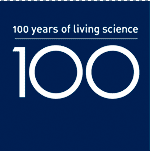Colin Grimshaw
(Media Services, 1965-present)
Meeting my past...in fast rewind!
I think I might have something in common with our famous past student H.G. Wells. I’ve invented a “Time Machine”. Well, not really a machine, but rather a way of going back in time. You see, since the late 1960’s I’ve been recording all types of things related to Imperial College. This is, of course, using magnetic tape in the form of audio, but more importantly videotape. Although the College Archives holds thousands of pieces of paper in the form of documents, books, journals, manuscripts, etc, its collection of sound and visual recordings (videotape and film) is surpassed by the videotape collection held by Media Services. This collection, very appropriately, hit the 500 mark in January 2007 with the Rector’s Centenary Lecture in the Great Hall. Some of these recordings now form items within the centenary history timeline, so you are once again able to see people and events that shaped the college and created its history. As a back-up, some key and more notable recordings have been duplicated and presented to the college’s archives, with many having been transferred to DVD.
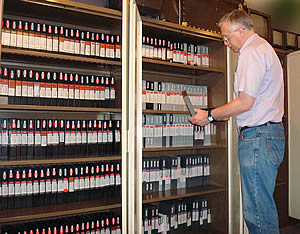
• Photo: Colin Grimshaw with just some of the 500 videotape recordings.
So what aspects of the college’s history have I recorded and why might they be important? I’ve picked a handful that stand out, either because of their importance to the college or because of something interesting associated with that recording or the people taking part in it.
Many have used videotape as a means of communicating an idea or concept. Professor Robert (Bob) Spence started this trend some 32 years ago as can be seen in this 1975 photo of him demonstrating the use of the computing programming language APL (which stands for A Programming Language).
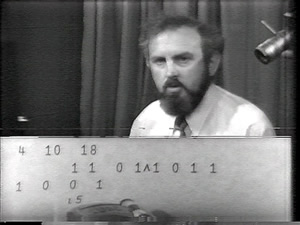
• Photo: Bob Spence studio demonstration of APL, 1975
But in 1979 Bob Spence made the first World’s first videotaped demonstration of a calculator built-in to a computer as part of his MINNIE Circuit Design System, thus paving the way for a series of notable firsts.
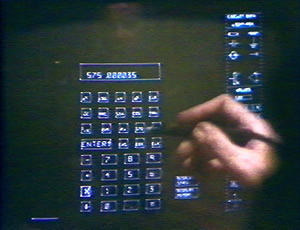
• Photo: Bob Spence using a light-pen with the first on-screen calculator, 1979
In 1980 I made a revolutionary video with Bob entitled “Office of the Professional”. In that video we saw interaction with people, information, technology and data. Everything in the video was made-up, only a few things really did exist, like the hand writing recognition system. All of the display screens were running from one of the three videotape players we used. Bob and his colleague had to synchronise their hand movements to my pre-recorded displays (as can be seen in the photo below). Even the desk, touchpad and screen surround were made from either cardboard or felt material, but it worked.
Bill Buxton in his 2007 book ‘Sketching user experiences’ is quoted as saying, in reference to the video, “….is the first example of envisionment videos that I am aware of….” and “….remarkable for its insights…and two years before the launch of the Apple Macintosh.” And finally he says of the video “…I have a lot of respect for those who made it.” Bill Buxton’s book is prefaced by Bill Gates. Once again, a small piece of history is recorded in our archive.
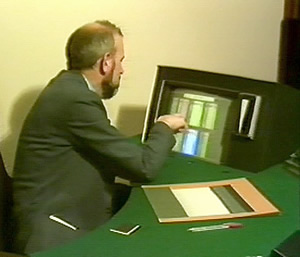
• Photo: Bob Spence using a touch screen in “Office of the Professional,” 1980
Teaching is just one aspect of our archive collection, our history and those that make it within college is another. As part of the current Centenary Celebrations we recorded (in 2006) interviews with all past Rectors, Lord Flowers, Sir Eric Ash and Lord Oxburgh. We are very fortunate to have a rare recording with Lord William (Bill) Penney made in 1971. Although crude, compared with today’s standards, it is an insight into the person who controlled Imperial College at a time when it was expanding. Included in the varied conversion he did touch upon his involvement with the Atomic Bomb project during and after the war.
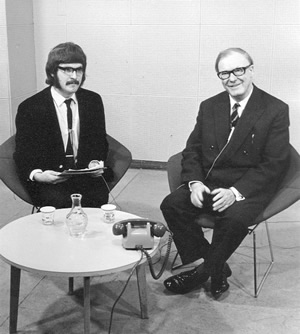
• Photo: Lord Penney (right) interviewed in 1971 by Dave Willis
Later in the 1970’s we interviewed, as Rector, Sir (subsequently Lord) Brian Flowers, along with Lady Flowers, in their home at 170 Queens Gate. A unique recording of their life and experiences whilst at the college.
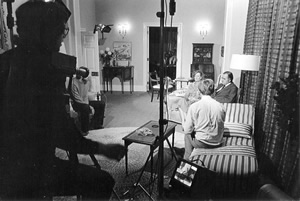
• Photo: Sir Brian and Lady Flowers interviewed at 170 Queens Gate
As I say, technology has changed, as the following two photos will show.
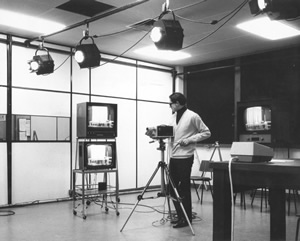
• Photo: Colin Grimshaw in the College's first TV Studio, 1968

• Photo: Martin Sayers in the TV Studio as it’s being used to link Lord George Porter’s presentation live to Singapore, 1995
Many famous and internationally known people visited the College TV Studio during its time of operation; the Duke of Kent was one such person during a visit by the Institute of Electrical and Electronic Engineers.
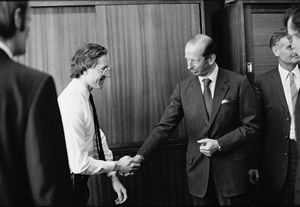
• Photo: The Duke of Kent is welcomed to the TV Studio by Colin Grimshaw, 1987
Recording in a studio is one thing, but we regularly create videos in all sorts of places. We have footage shot at the -now closed- college tin mine in Cornwall; a plastics factory in Spain; a China Clay Pit in Cornwall and so on. The following five photos are examples of this.
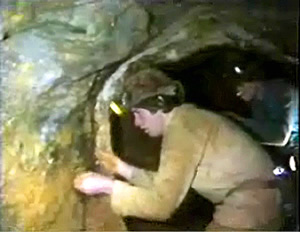
• Photo: An early mid 1980’s colour recording shot underground at the college’s tin mine
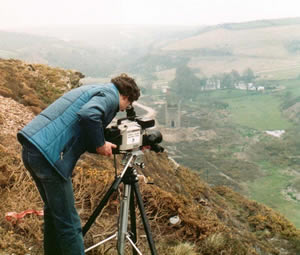
• Photo: Colin Grimshaw in the hills around the college’s old Cornish tin mine
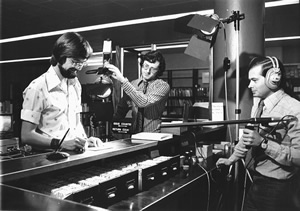
• Photo: Shooting a guide to the college’s “Life Sciences Library” with Neville Miles (right) on sound, 1970's
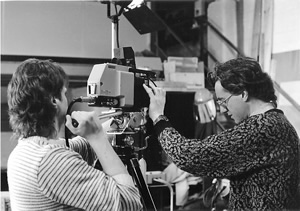
• Photo: Andy Moore (left) and Colin Grimshaw recording a laboratory experiment, 1986
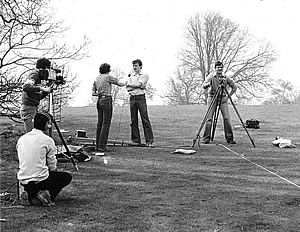
• Photo: An insight into the workings of Silwood Park, shot in the mid 1980’s with Tracy Poole interviewing
Many of the things mentioned have played a part in Imperial College’s Centenary year celebrations. Even those events making up this year are themselves being added to our archive: the Centenary Ceremony; the Staff Party and so on. It’s not until you look back, as we have all been doing this year, that you realise the importance of recordings such as these and you can appreciate the people and their involvement with Imperial College. It’s not just a collection of people who may no longer be with us, it’s a collection of what we have all achieved, even the smallest contribution may have been captured and saved to be viewed again in years to come. As a policy, any videotape accessed from our collection is now transferred to DVD at the highest possible quality. This will not only make access and duplication easier, but will also help in the event of a tape becoming unplayable.
I’ve been very lucky to work with many very important people in science including several Nobel Laureates. I’ll always remember a visit to the studio by Prof Denis Gabor (Inventor of Holography) who, when leaving, looked at a Sony Colour Monitor and said to me “…..I invented that……” What he was referring to was the single electron gun technique that the monitor employed.
Back in early 1974 the tables were turned on me when I was approached by Prof Eric Laithwaite (Inventor of the Linear Induction Motor). He had been asked to present the 1974 Royal Institution Christmas Lectures. The theme was Alice through the Looking Glass and so it was therefore called “The Engineer through the looking glass”. The request to me was how he could do something like talking backwards as part of lecture 3 “Jam Yesterday, Jam Tomorrow”. We chatted for ages about possibilities and as I knew him well, he said he’d leave it to me to come up with some ideas. What I did, but what I did not tell him, was that I had made a complete sound sequence where I was talking backwards. When that itself was played backwards, it came out forwards! Believe me it did work. Upon hearing my efforts of “Merry Christmas and Happy New Year……….” his face lit up and he said “OK you can present it during the lecture”. And so, as can be seen in the photo, I made my appearance on BBC2 on New Years Eve on the 31st January 1974.
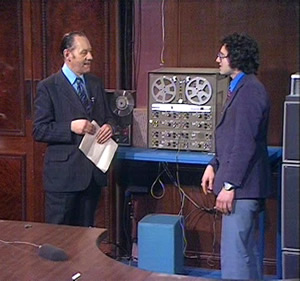
• Photo: Professor Eric Laithwaite and Colin Grimshaw on BBC2’s Royal Institution Christmas Lectures “Engineer through the looking glass,” 1974
© 2007 Imperial College London
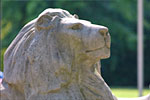
Through the first decade of the twenty-first century the campaign seeks to philanthropically raise £207 million from Imperial’s alumni, staff and friends, and donations from charitable foundations and industry.
Where your support can make a differenceGive now

Imperial’s Centenary Year provides an opportunity to recognise and celebrate members of the Imperial community.
View staff and student portraits
